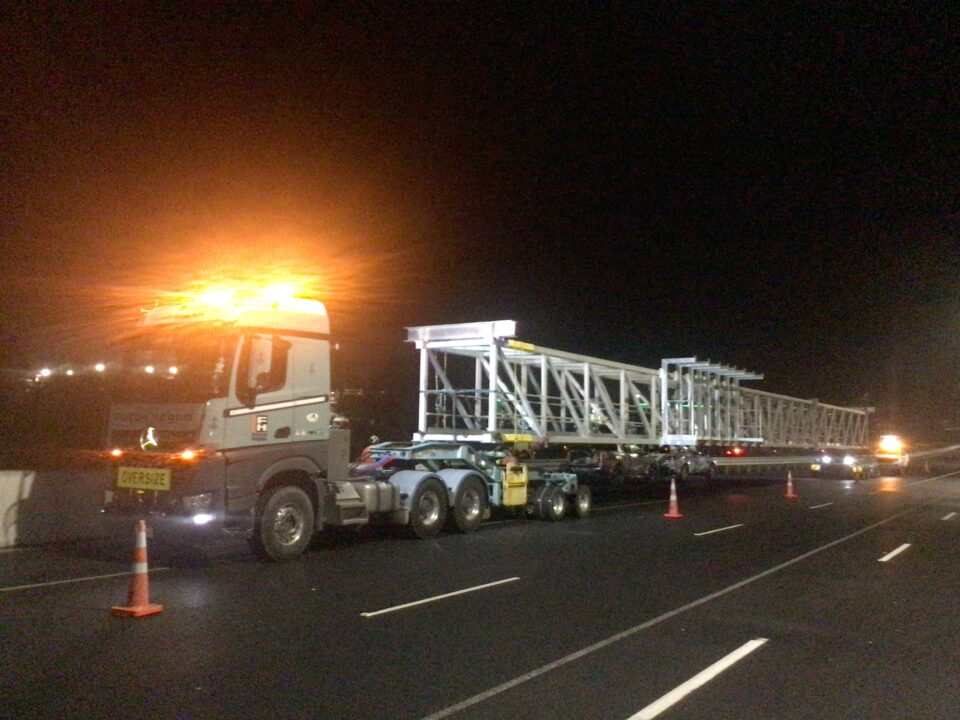Fulton Hogan is one of this country’s most well-known and largest road and infrastructure contractors, with a history that goes back some 90-plus years. Richard Silcock looks at the major contractor’s heavy haulage business.
What is perhaps less well known is that Fulton Hogan has for the last eight years operated a specialist heavy haulage division based out of both Auckland and Christchurch.
“We have been involved in transporting our own equipment and materials for a long time, but it wasn’t until more recently that we got involved in transporting heavy and overdimension loads for other companies and clients,” says Phil Powell, manager of Fulton Hogan’s heavy haulage division in Auckland.
“Here at our Auckland base, we have a staff of 18; 16 of whom are licenced as both heavy haulage drivers and pilots. Combining the two has worked well for us as it means the two roles are interchangeable and when a driver is acting as a pilot, he or she knows what is expected of them and the information that will assist the driver when navigating a difficult route.
“Our Auckland operation tends to transport loads around the North Island, while in Christchurch they do most of the South Island work.”
The company operates several heavy haulage truck and trailer units from their yard in Mount Wellington and Phil says it depends on the type and weight of the load as to what equipment they use.
“Our 600hp Scania transporter units do most of the ‘heavy lifting’ and together with our MTE trailers, which have various wheel and axle configurations ranging from three rows of eight wheels through to five rows of eight wheels, we have the capacity to carry over 80-tonne loads.
“In addition, we have two special beam trailers to carry Super-Tee concrete beams of over 90 tonnes and two remote load dividers (jinkers) which can be controlled from the driver’s cab or remotely by a second person when negotiating a tight turn or reversing.
“We also have an eight-wheeler rigid transporter and an extendable trombone trailer which we use for smaller jobs.
“Some of our recent large loads have included transporting a 90-tonne excavator from wharf-side in Auckland to the Stevenson’s Quarry in Drury, South Auckland. The excavator bucket alone weighed seven tonnes and had to be transported separately.
“Another exercise involved transporting 33-metre-long, 55-tonne Super-Tee concrete beams from our precast plant in West Auckland to Puketapu in Napier for the construction of a bridge.
Permits had to be requested from not only the NZTA, but also from the various local councils and other authorities our route traversed, as these included both state highways and local roads and required negotiating SH5 between Taupo and Napier, which is quite twisty in places with some sharp bends and steep descents. It took 20 separate loads over four weeks to complete.
“The transporting of beams for the new Kaeo Bridge, on SH5 in Northland, was another heavy and long load of around 35 metres and it required some careful driving expertise, especially through the difficult and slip-prone Brynderwyn section of the highway.”
For the 56 turbine, Mahinerangi Wind Farm near Dunedin, Fulton Hogan Heavy Haulage transported 12 wind farm towers to the construction site for Trustpower. This involved surveying the route and compiling a comprehensive plan for their safe delivery, along with working closely with the client and the shipping agent at Port Chalmers, obtaining permits for the oversize load and organising cranes to lift the towers from the transport trailers at the site.
“Another interesting job involved getting an EK60 drilling rig to a site in Auckland’s CBD,” explains Phil.
“It required the thorough checking of the route for low-hanging power lines, overhanging tree branches and traffic islands, and liaising with the appropriate authorities over traffic management. As the street was narrow and a dead end there was very little room to manoeuvre or turn the truck and it required us to reverse along the street to offload the rig. No other traffic or parked vehicles were allowed in the street while we were working as a safety precaution.
“Due to the size and width of some loads we often must drive in the centre of a road or highway, and this can mean we have to completely close off sections as we move through. We work closely with the authorities to ensure minimal traffic disruption and usually carry out this type of work at night, usually between midnight and 6am.
“While not always a requirement, we ensure we have at least two or three pilot vehicles assisting in cases like this, not only for assisting the driver in negotiating obstacles such as tight roundabouts, narrow bridges and underpasses, but to also ensure the safety of other traffic.
“Unfortunately, some impatient drivers will ignore signals given by our pilots to pull over and wait for us to pass by and this can be problematic, especially where the load width overhangs the centre line of the road.
Regrettably this is becoming more common, and while we have not had a serious incident, such behaviour is dangerous.
“Over summer and in particular when it is hot, some asphalt road surfaces can become soft and when a truck and trailer unit with a heavy load pass over it, the surface can be damaged or rutted, so we are mindful of avoiding situations such as this wherever possible,” says Phil.
“Careful planning of the route, knowing the obstacles and having a skilled workforce are the main criteria in this industry, along with obtaining the necessary permits and taking the upmost care of the load being transported.”


Consideration of oversize load movers